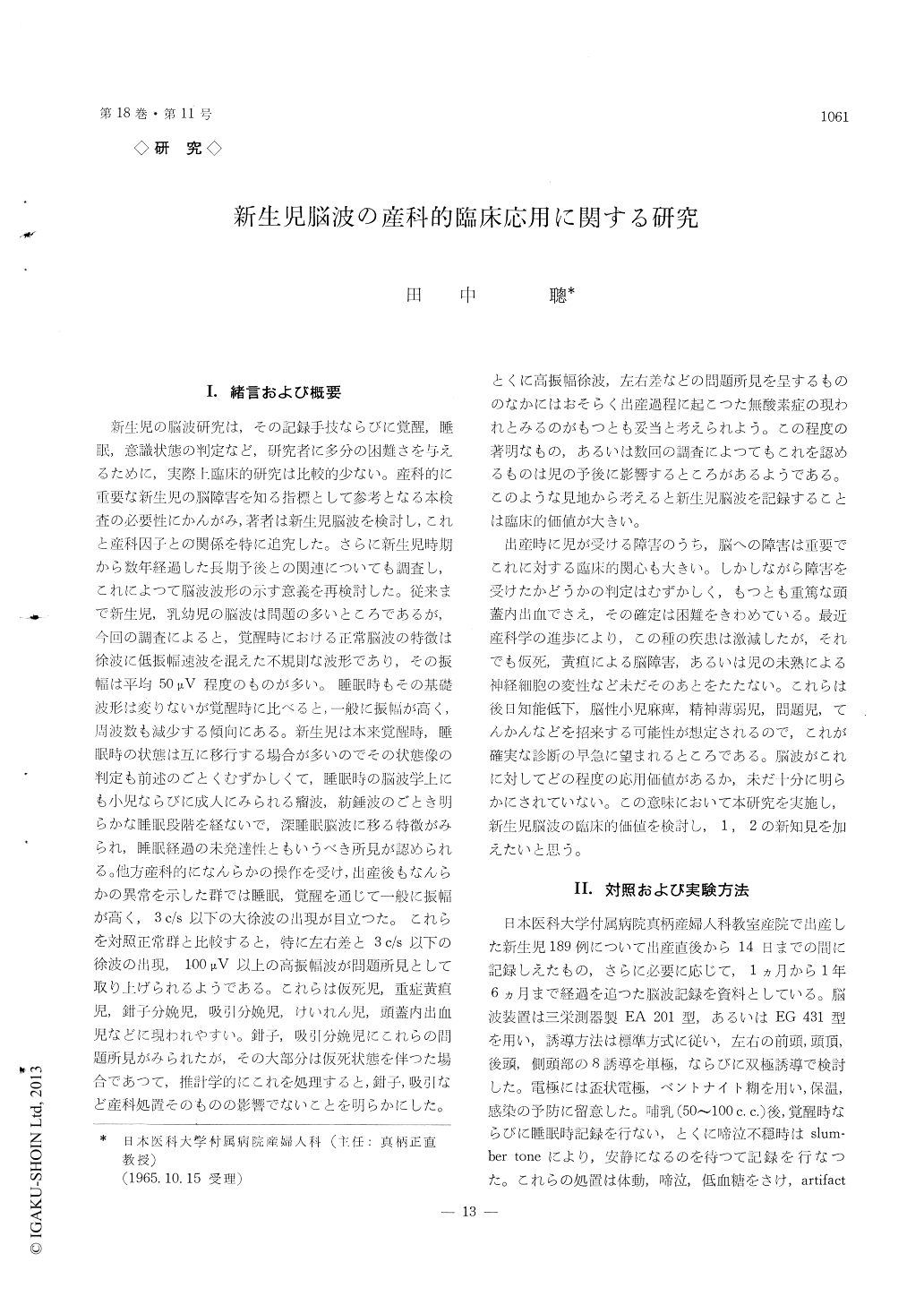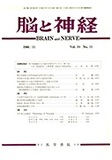Japanese
English
- 有料閲覧
- Abstract 文献概要
- 1ページ目 Look Inside
I.緒言および概要
新生児の脳波研究は,その記録手技ならびに覚醒,睡眠,意識状態の判定など,研究者に多分の困難さを与えるために,実際上臨床的研究は比較的少ない。産科的に重要な新生児の脳障害を知る指標として参考となる本検査の必要性にかんがみ,著者は新生児脳波を検討し,これと産科因子との関係を特に追究した。さらに新生児時期から数年経過した長期予後との関連についても調査し,これによつて脳波波形の示す意義を再検討した。従来まで新生児,乳幼児の脳波は問題の多いところであるが,今回の調査によると,覚醒時における正常脳波の特徴は徐波に低振幅速波を混えた不規則な波形であり,その振幅は平均50μV程度のものが多い。睡眠時もその基礎波形は変りないが覚醒時に比べると,一般に振幅が高く,周波数も滅少する傾向にある。新生児は本来覚醒時,睡眠時の状態は互に移行する場合が多いのでその状態像の判定も前述のごとくむずかしくて,睡眠時の脳波学上にも小児ならびに成人にみられる瘤波,紡錘波のごとき明らかな睡眠段階を経ないで,深睡眠脳波に移る特徴がみられ,睡眠経過の未発達性ともいうべき所見が認められる。他方産科的になんらかの操作を受け,出産後もなんらかの異常を示した群では睡眠,覚醒を通じて一般に振幅が高く,3c/s以下の大徐波の出現が目立つた。これらを対照正常群と比較すると,特に左右差と3c/s以下の徐波の出現,100μV以上の高振幅波が問題所見として取り上げられるようである。これらは仮死児,重症黄疸児,鉗子分娩児,吸引分娩児,けいれん児,頭蓋内出血児などに現われやすい。鉗子,吸引分娩児にこれらの問題所見がみられたが,その大部分は仮死状態を伴つた場合であつて,推計学的にこれを処理すると,鉗子,吸引など産科処置そのものの影響でないことを明らかにした。
とくに高振幅徐波,左右差などの問題所見を呈するもののなかにはおそらく出産過程に起こつた無酸素症の現われとみるのがもつとも妥当と考えられよう。この程度の著明なもの,あるいは数回の調査によつてもこれを認めるものは児の予後に影響するところがあるようである。このような見地から考えると新生児脳波を記録することは臨床的価値が大きい。
In waking state, the E. E. G. of normal newborn infants shows mostly the irregular slow waves with medium amplitude of about 50 micro V, accompany-ing irregular quick waves with low amplitude and their peaks are in a range of c/s and 14-20 c/s and little difference is observed in the right and the left sides. Large waves with amplitude more than 100 micro V can scarcely be observed. E.E.G. of newborn infants in sleeping time was hardly distinguishable from that in the waking state but in the carefully prepared and provocated findings of E. E. G. in sleep-ing time the transitional changes from sleeping to waking were not clearly observed as in the adults and the waves and spikes during this period were unripe and incomplete.
No significant change was observed in the right and the left in sleeping and waking.
In E. E. G. of newborn infants which showed more or less some kinds of distresses after the deliveries, the appearances of differences of the right and the left and of the intermittent sporadic large slow waves with high amplitude in a range of 0.5-3 c/s were significantly more observed in comparison to the con-trol group with normal perinatal courses, which might be considered as the specific findings in such cases.
In no case abnormal findings with spike waves, spi-ke and wave complexes and sharp waves were observ-ed.
Slow waves with high amplitudes, existence of the differences of the right and the left were prevalently seen in cases of asphyxia, forceps- or vacuum deli-veries, intracranial bleeding or icterus.
It was clarified that the abnormal findings seen in cases of forceps-or vacuum deliveries had close rela-tions to the existence of asphyxia at the delivery and they were not directly caused by the obstetrical ma-nipulations of forceps- or vacuum deliveries but pre-sumably by the direct cerebral influence of the anoxia complicated at the delivery. It was also found that abnormal E. E. G. was not seen even in cases of protracted deliveries or prolonged courses after the rupture of the membrane, unless asphyxia was complicated in those cases.
No specific relation was observed between the find-ings of E.E.G. and gestational months, body weight at the delivery, cephalic hematoma and cephalematoma but in cases of complicating bleeding of the eye grounds the abnormal findings were often observed.
Some cases of the newborn infants which revealed abnormal findings of E. E. G. showed relatively poor prognosis in the long courses, compared to the normal control group, for example, in regards to the time of beginning of speaking, standing by leaning, self stand-ing or self walking and etc.

Copyright © 1966, Igaku-Shoin Ltd. All rights reserved.


